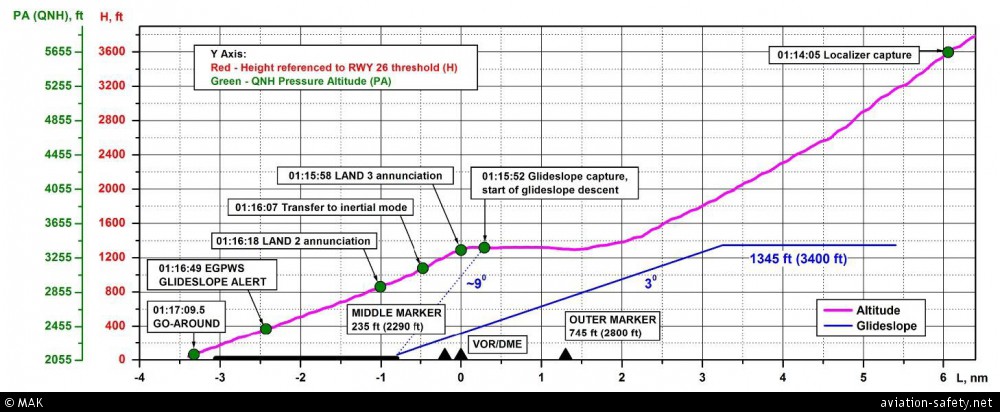Pilots of crashed 747 missed cues about off-course approach

Pilots of the ill-fated Boeing 747-400F which crashed at Bishkek were given several warnings and indications that the aircraft was not following the correct approach before it overshot the airport.
The MyCargo Airlines aircraft had been too high on the approach to runway 26 and failed to intercept the 3° glideslope from the ILS.
Instead its autopilot followed the instruction to level off and maintain altitude at 3,400ft - putting it some 50% higher, in relation to the glideslope and the ground, than it should have been.
Russia's Interstate Aviation Committee states that crew's glideslope deviation indicator was showing the "full down" position, indicating that the jet was "significantly" above the descent path.

But the approach, conducted in darkness and fog, remained uncorrected. The 747 was still in level flight at 3,400ft when it passed the outer marker, about 2.1nm before the runway, which should have been overflown at 2,800ft according to the approach chart.
While the cockpit-voice recording contained no aural alert when the marker was passed, the inquiry says the marker is "indicated" to both pilots on their primary flight display.
Although the aircraft began to descend shortly after crossing the outer marker, this was the result of an inadvertent capture of the false 9° glideslope reflection from the ILS.
The aircraft then passed over the middle marker - situated 0.6nm before the runway - and, again, this was signalled on the pilots' displays although there was no aural notification.
This middle marker was supposed to be overflown at an altitude of 2,290ft - or 235ft above ground - but was instead passed at 3,300ft. The late descent meant the aircraft overflew the entire length of the 4,200m runway.
Both pilots' navigation displays were set to 'map' mode, with a 10nm scale.
The glideslope deviation indicator was "fluctuating" by four dots either side of neutral, says the inquiry into the 16 January crash.
It adds that, after the false glideslope capture, the aircraft issued a series of cautionary alerts because it was not tracking the glideslope.
"These events were continuously recorded almost until the end of the flight," says the inquiry.
Some 20s before impact the enhanced ground-proximity warning system was triggered five times, issuing alerts on glideslope deviation over the space of 6s. The inquiry states that these alerts sound when the aircraft deviates below the glideslope - the volume of the warning depending on the height above ground and the size of the deviation.
Although the crew attempted a missed approach, only after failing to sight the runway at the decision height, belated execution of the go-around resulted in the 747's striking the ground having already flown beyond the end of the landing runway.

Ingen kommentarer:
Legg inn en kommentar
Merk: Bare medlemmer av denne bloggen kan legge inn en kommentar.